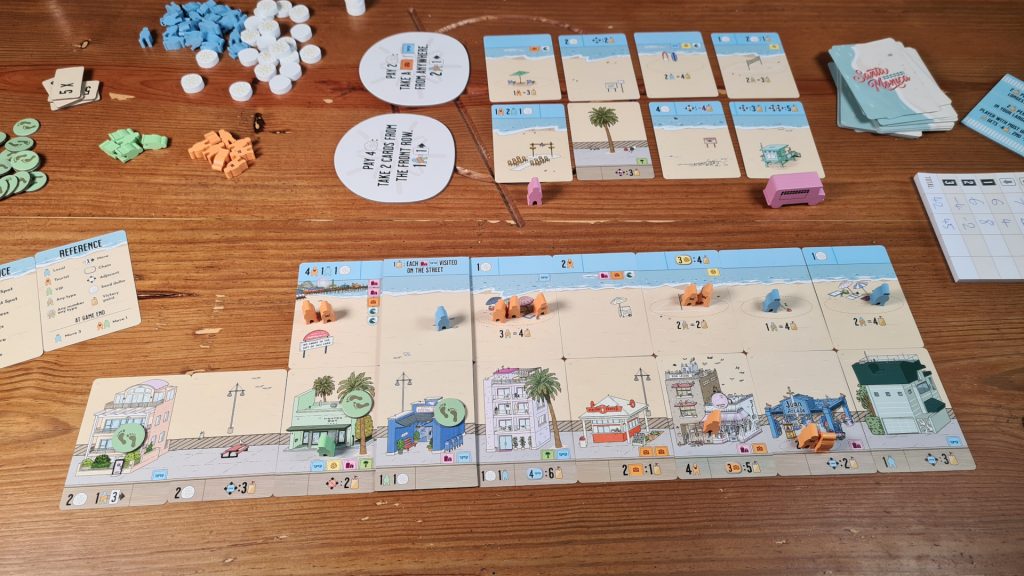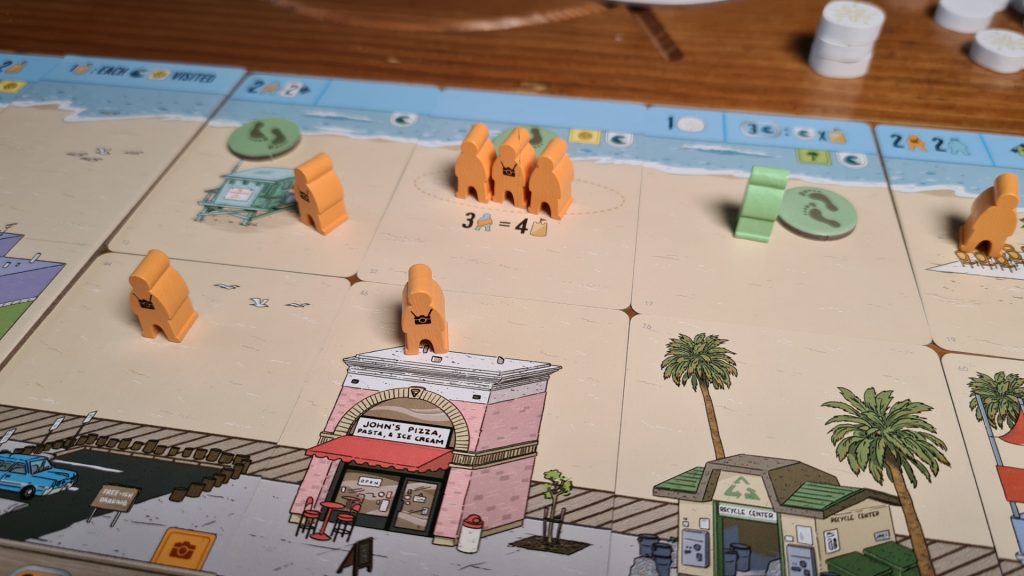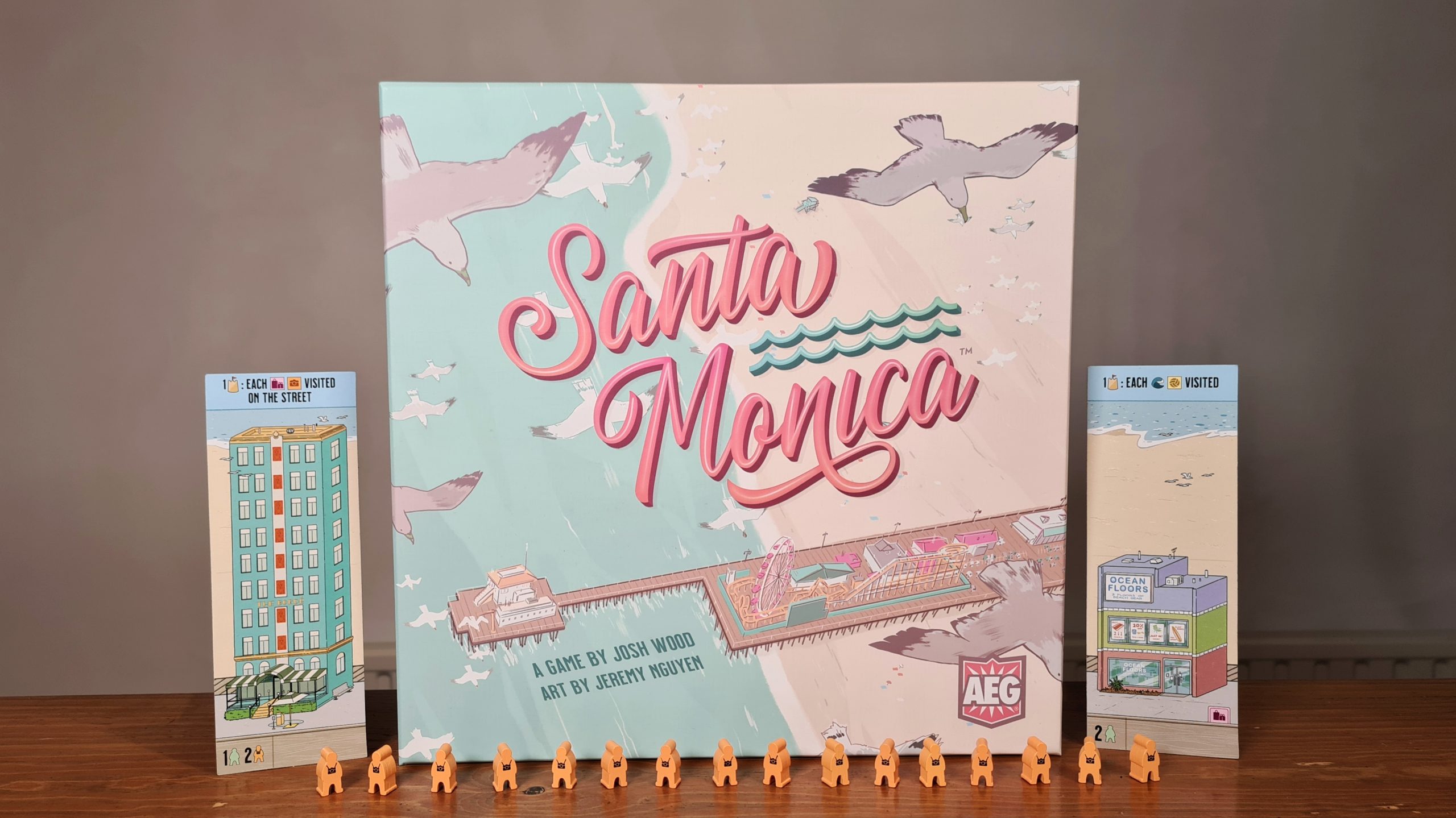Santa Monica is a set collection and card placement board game from publisher AEG (Alderac Entertainment Group). Designed by Josh Wood, featuring artwork from Jeremy Nguyen, the game sees 2 – 4 players build out the street and beach along the front of Santa Monica. Tourists, locals and VIPs will pop up along the street, with activities for them to move to along the beach. However, is this a beach to play? Let’s find out!
Setup is almost as simple as shuffling the deck and randomly choosing a few tiles. Once shuffled the deck is used to create a market of 8 cards, made from two rows of 4, with two sand dollar tiles put into play adjacent to the market and a scoring objective tile selected. Each player starts with a double tile, featuring a street and beach section. Each of these features a special game end scoring opportunity for that player, with at least 1 VIP meeple to start with on that tile.
On a player’s turn they will gain a card, place it into their display and then refresh the market. By default players will choose one of 4 cards from the front row, which may trigger bonuses from a foodie meeple and food truck which move along the market. Instead, a player might pay to activate the power of a sand dollar tile. Commonly, this will see them take at least one card from the market and trigger a meeple movement, but not any bonuses from the foodie or food truck.
When adding a card to your display it must be adjacent to either your starting tile or a previous played card. If it is a beach it must go in your top row and if it is a street it must be placed in your bottom row. Regardless of which type it may come with a placement action, from gaining sand dollars to spawning meeples, or even meeple movement. Any meeples gained start on the newly placed card. Via future movement actions players will want to shift them around their slowly growing beach scenes to get different meeples into activity rings on specific cards – as these are one way to score points. After this the market is refreshed, with the back row card of the empty column sliding down into the front row, with play moving on clockwise.

Tourists and visitor meeples aren’t the only way to score. Some cards come with chain or adjacency scoring conditions. Nothing is scored until the end of the game so it doesn’t matter when placed if the condition, for example having four nature tag cards chained together, isn’t yet met. Each game one of the three end game scoring tiles is randomly selected, with the blue one recommended for your first game. These give bonus points for wave tags and such, even losing points for meeples not used for activity rings! The game ends at the end of a round when any player has placed 14 cards into their beach display, and whoever has the most points wins.
Having the different scoring opportunities forces players to make compromises, focusing on one point scoring opportunity often at the hindrance of another. When a player needs that one more business tag card to score a big chain, but there’s none in the front row the sand dollar tiles can open up the back row. Rarely will the perfect card present itself, so you have to work with what you can get from the market.
Including the foodie and food truck at the bottom of the market is a great way to give players little bonuses. It would be hard to get a flow of sand dollars coming in without the food truck, and whilst not constantly activated it is enough just to allow players that extra use or two of the sand dollar tiles. With some cards spawning 4+ meeples the foodie’s bonus movement helps players to maneuver VIPs for points or locals into circles.
There are a few especially interesting cards, such as one that adds an additional limitation – stopping the player building any more beach cards to the left of it. However, these won’t necessarily come out of the deck. For example, in a two player game players won’t go half way through the deck. This can see very varied games, with one dominated by tourist spawning cards, lots of movement with almost no locals and the next the reverse. This isn’t quite the case with additional players as more cards are taken and therefore more of the deck is cycled through during the game.

A negative of this cycling is when playing with 4 a lot of the market can change between your turns. Depending on the sand dollar tiles in play up to 6 of the 8 cards could change. As a result, it feels pointless to eye up any cards to take, until at least some of those opponents have taken their turn. This just means there is a little amount of downtime, though as individual turns aren’t long, with the momentum of the game going around the table, this isn’t a long and obvious downtime.
By the end of the game each player will have an awesome looking beach vista. From quirky looking shops on the streets to wedding locations, beach volleyball courts and surfboards along the shoreline. By splitting the cards into two types, street or beach, and based on this having their icons appear at the top or bottom of the cards it keeps the vista clear. This still enables the icons to be easily read whilst the created beach is enjoyed. For the most part the iconography works well, though a few times the rules needed to be checked to see if something meant it was scored per something or just if it was perfectly completed. With repeat plays this does go away but that first game or two had us checking the rulebook a few times for clarifications.
Having a number of starting tiles, sand dollar tiles and even scoring tiles to randomly choose from changes things up enough from one game to the next. The entire experience isn’t changed but with the special actions from sand dollar tiles shaken up and perhaps long rows of waves no longer needed players get to try different methods to win, so you’re not stuck always taking the same cards. The sand dollar tiles are double sided but unfortunately the scoring objective tiles and the starting tiles aren’t – featuring the same artwork/scoring opportunities on both sides. This just feels like a slight missed opportunity to get even more variety into the game.
Santa Monica is simple to teach, as on a turn you are mostly just taking a card from the front row of the market and placing it somewhere into your display of cards. The choices come from the actions the placements give, as well as the two randomly selected sand dollar tiles. There’s enough so there’s hardly ever a single card you might want, without overloading players with countless choices. Combining finishing with a large beach vista in front of you with all of the ways to score, even if you don’t score highly you will feel like you’ve managed to do something in that game. Santa Monica has that great balance of being easy to get to the table but then choices when it’s there, meaning it has earnt its spot on my gaming shelf!
(Editor’s Note: Santa Monica was provided to us by Asmodee for the review. It is currently available from local board game stores! Find your local store here.)

